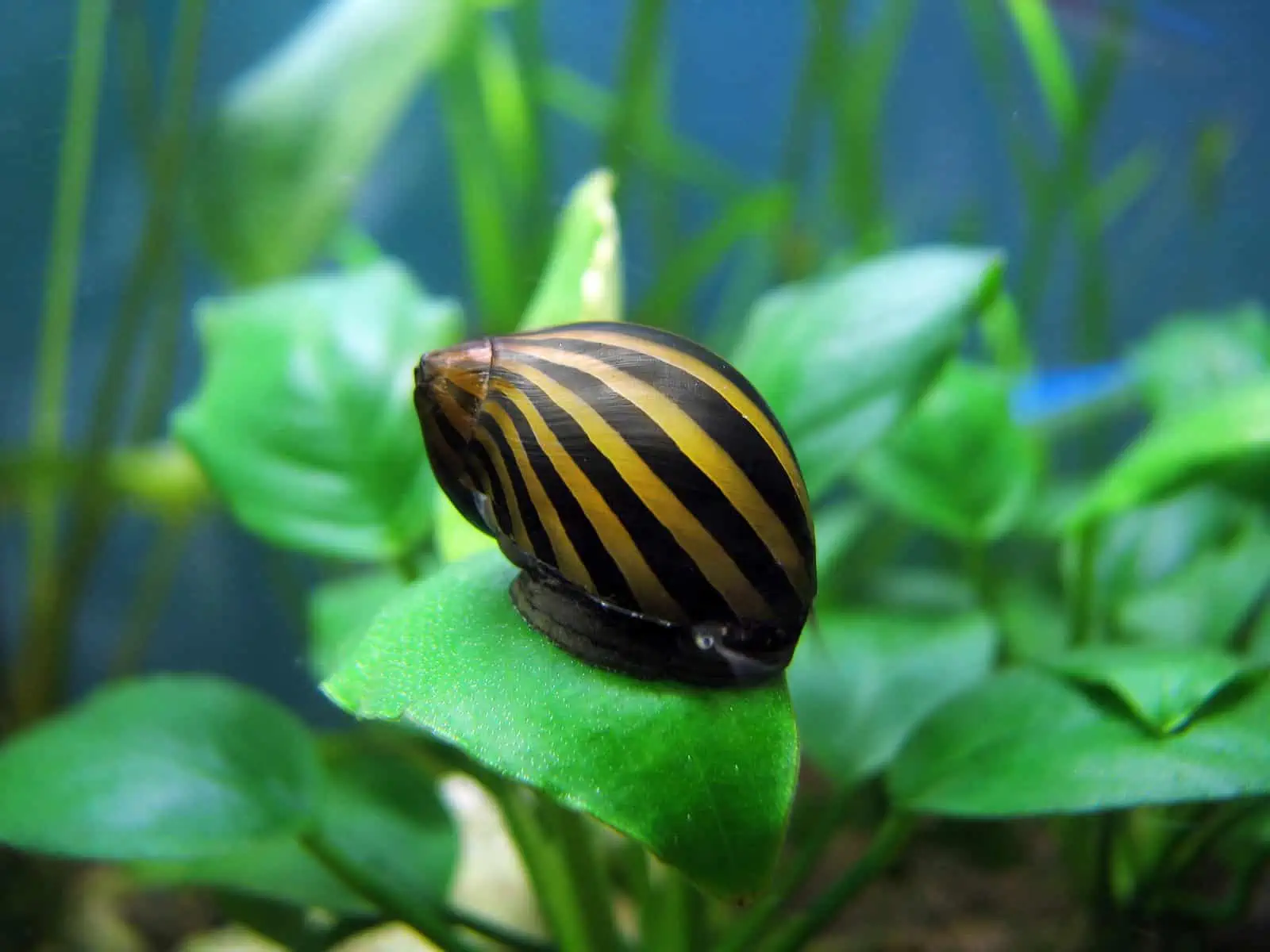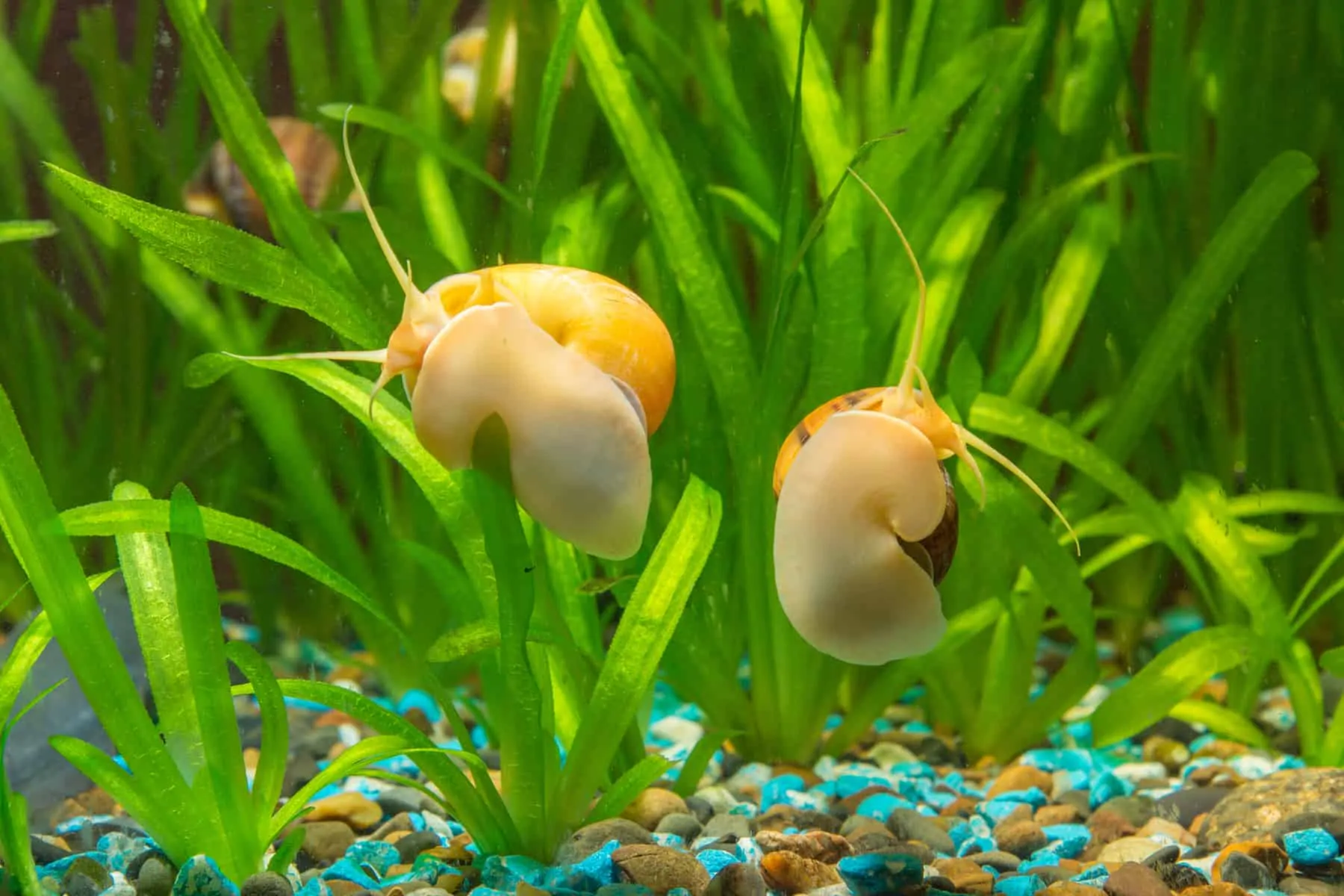Goldfish are infamously messy fish and it’s not unusual to see their tanks covered in algae. Since snails are one of the best algae eaters, many fish keepers have asked the question: Can goldfish live with snails?
The answer is that snails can sometimes live with goldfish, but you need to get the combination right.
In this article, we’ll explore which types of goldfish can live with which types of snails for your best chance of a harmonious match.
Why Keep Snails With Goldfish?
The most common reason that people choose to keep snails in their fish tanks is to clean the tank from algae.
Commonly kept pet snails like nerite snails, mystery snails, rabbit snails, and ramshorn snails are all excellent algae eaters. Not only do they help to keep the gravel, rocks, and plants free from a green, slimy coating but also help to keep aquarium glass crystal clear for your viewing pleasure.
You may know that algae love to grow in poor-quality water where nitrate and phosphorus levels are particularly high. Because goldfish are notoriously messy fish, algae can be especially problematic in their tanks.
It’s not unusual for goldfish keepers to search for an algae eater to help keep their tank clean, and snails are one possible candidate. But do snails really make good tank mates for goldfish?
Do Goldfish Eat Snails?
The main problem with keeping snails with goldfish is that goldfish will sometimes eat them!
Like most fish, goldfish are omnivorous opportunists and will try to eat most things that they can fit in their mouths. This can include small fish, shrimp, and mollusks such as snails.
If you want to keep snails with goldfish then you’ll need to choose the largest, most robust snails possible to resist the carnivorous instincts of your goldfish, which will doubtless be looking for a tasty, high-protein snack!
Which Types of Snails Can Live With Goldfish? Three of the Best!
Nerite Snails

- Scientific Name: Vittina natalensis
- Water Temperature: 65–83°F
- Maximum Size: 1 inch
- Average Lifespan: 1-2 years
At an inch in diameter, and with a tough shell, mature nerite snails should be able to hold their own against most small-medium size goldfish (although not always with larger goldfish!).
Nerites are also famous for being one of the very best algae-eating snails and will spend their days hoovering up massive quantities of soft film algae, soft green algae, soft brown algae, and brown diatoms. Sadly, green-spot algae seems to be one of the few types of algae that they won’t eat.
As well as being incredibly beautiful, nerite snails have the added advantage of not being able to breed in freshwater, meaning this species will never crowd out your tank.
On the flip side, nerites only live for a couple of years at most, so you will have to replace them relatively frequently. They also prefer higher water quality than some other snails.
Mystery Snails

- Scientific Name: Pomacea bridgesii
- Water Temperature: 68–82°F
- Maximum Size: Up to 2 inches
- Average Lifespan: 1-2 years
If you don’t think that nerite snails will be large enough to fend off your hungry goldfish, maybe you should consider the monstrous mystery snail!
As part of the apple snail clan, mystery snails are among the largest of commonly kept aquarium snails, and their 2-inch shell should be more than enough to see off most goldfish.
One theory of how mystery snails earned their name is their bizarre way of disappearing and reappearing in the tank. If you’re worried your goldfish might have eaten yours, don’t give up! They may well show up again a few days later.
Another possible reason for their name is that mystery snails can reproduce at a staggering rate. Thankfully, your goldfish will probably be more than happy to pick off juvenile mystery snails and help you keep their population in check!
Mystery snails may not be as efficient as nerite snails in keeping your tank clean, but they will still consume plenty of algae, making light work of small infestations.
Japanese Trapdoor Snail
- Scientific Name: Viviparus sp.
- Water Temperature: 66-78°F
- Maximum Size: 2-3 inches
- Average Lifespan: 3-10 years
Exceeding even the mighty mystery snail in size, Japanese trapdoor snails are among the heavyweights of pet snails. Their stocky shell can reach a massive 3 inches, making them among the most robust aquarium snails available.
Japanese trapdoor snails are also excellent algae eaters – so good, in fact, that you might need to supplement their diet with algae wafers to keep them well-fed!
While this species of snail can breed in captivity, they are much less prolific than mystery snails. Mothers only tend to give birth to a maximum of 15 young in a single brood, as opposed to the several hundred eggs that mystery snails lay!
Another remarkable asset of these snails is how long they live. Whereas most aquarium snails will only live for a few years, Japanese trapdoor snails can live for over 10 years. They might even outlive your goldfish!
Which Types of Goldfish Can Be Kept With Snails?
As the longest-kept captive fish, goldfish come in a bewildering array of shapes and sizes. Inevitably, some goldfish varieties are going to be more suitable tank mates for snails than others.
The most significant factor concerning goldfish compatibility with snails is goldfish size – smaller breeds are less likely to eat snails than larger breeds.
Typically, the largest breeds of goldfish are the single-tailed varieties. These include common goldfish, comets, and shubunkins.
Fancy goldfish such as Ranchu, Ryukin, and Pearlscale goldfish usually grow to a smaller size than single-tailed goldfish breeds and so are often less capable of tackling large snails such as mystery snails.
It should be understood, however, that fancy goldfish are often stunted in growth by intensive breeding programs that some aquarists deem as cruel.
Fancy goldfish often exhibit bent spines, swollen eyes, and unnatural fins that can severely hamper their health and swimming ability. These are important points to consider before buying one!
Can Goldfish Help To Eat Pest Snails?

Another reason that you might be considering keeping goldfish with snails is if you have a pest snail problem and are looking for a predatory fish to eat them all!
Certain types of snails like mystery snails and Columbian ramshorn snails are notorious for over-breeding, meaning some people find their tanks overrun by these mollusks. If they run out of algae to eat, some snail species may even begin to damage aquarium plants.
By eating young snails and snail eggs, goldfish with a taste for snail meat could help to control a large snail population, but maybe some better options, too.
Because this is a common issue, we created a dedicated page for fish that eat snails here.
Other Algae Eaters To Keep With Goldfish
If you’re not sure that snails are going to make the perfect match for your goldfish, you might be wondering what other types of algae eaters might be more suitable for your tank.
Several members of the catfish family make potential candidates, but many species demand higher water temperatures and better water quality than is normally found in goldfish tanks. Large shrimps are another option, but only with smaller goldfish.
Once again, we’ve devoted an entire webpage to this important topic with plentiful suggestions.
Other Ways To Reduce Algae in Goldfish Tanks
Adding fish and invertebrates that like eating algae is a great way to reduce algae that already exists in goldfish tanks. But what’s the best way to prevent algae blooms from occurring in the first place?
A Good Aquarium Filter
An essential line of defense against excessive algae growth in any type of fish tank is a good aquarium filter. Despite common myths, goldfish need an efficient aquarium filter just as much as any other fish.
For 30-gallon aquariums, a couple of well-maintained sponge filters could provide adequate filtration.
For large tanks, you’ll need to install a hang-on-back filter or canister filter. Because these tend to create a stronger flow than goldfish like, consider adding an aquarium spray bar or lily pipe.
Partial Water Changes
Another essential aspect of good aquarium maintenance is regular partial water changes.
By swapping out 20-35% of your tank’s water every 1-2 weeks with treated water of matching temperature, nitrate, and phosphorus levels are reduced, thus decreasing algae outbreaks.
Tank Vacuuming
An excellent way of removing water from the tank during partial water changes is to vacuum the substrate with a purpose-made aquarium hoover.
By sucking out dirt and debris from the gravel, tank vacuuming significantly reduces organic matter in the tank, which algae feed from.
Avoiding Overfeeding
Last but not least, one of the most important ways to prevent algae problems is avoiding overfeeding.
Overfeeding makes goldfish produce more waste, and any uneaten food also ends up rotting in the tank, polluting the water.
This all-too-common mistake nearly always results in algae blooms and sometimes in sick or dead fish, too.
Conclusion
Goldfish can sometimes be kept with aquarium snails, but both fish and mollusks must be chosen carefully. Since goldfish can sometimes eat snails, a combination of larger snails with smaller goldfish provides the best chance of success.
To learn about other good tank mates for goldfish, don’t miss our dedicated guide, here.


